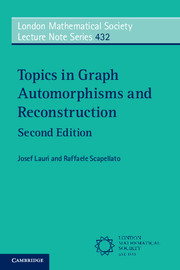Book contents
- Frontmatter
- Dedication
- Contents
- Preface to the Second Edition
- Preface to the First Edition
- 1 Graphs and Groups: Preliminaries
- 2 Various Types of Graph Symmetry
- 3 Cayley Graphs
- 4 Orbital Graphs and Strongly Regular Graphs
- 5 Graphical Regular Representations and Pseudosimilarity
- 6 Products of Graphs
- 7 Special Classes of Vertex-Transitive Graphs and Digraphs
- 8 The Reconstruction Conjectures
- 9 Reconstructing from Subdecks
- 10 Counting Arguments in Vertex-Reconstruction
- 11 Counting Arguments in Edge-Reconstruction
- References
- List of Notations
- Index of Terms and Definitions
4 - Orbital Graphs and Strongly Regular Graphs
Published online by Cambridge University Press: 05 June 2016
- Frontmatter
- Dedication
- Contents
- Preface to the Second Edition
- Preface to the First Edition
- 1 Graphs and Groups: Preliminaries
- 2 Various Types of Graph Symmetry
- 3 Cayley Graphs
- 4 Orbital Graphs and Strongly Regular Graphs
- 5 Graphical Regular Representations and Pseudosimilarity
- 6 Products of Graphs
- 7 Special Classes of Vertex-Transitive Graphs and Digraphs
- 8 The Reconstruction Conjectures
- 9 Reconstructing from Subdecks
- 10 Counting Arguments in Vertex-Reconstruction
- 11 Counting Arguments in Edge-Reconstruction
- References
- List of Notations
- Index of Terms and Definitions
Summary
In this chapter we shall define and explore the most basic properties of what are called orbital graphs. We shall see that, analogously to coset graphs, any vertex-transitive graph is a (generalised) orbital graph. Moreover, this description gives us, in principle, a criterion for arc-transitivity. Consideration of a special type of orbital graph will lead us to strongly regular graphs.
Definitions and basic properties
We have seen in Chapter 1 that, given a permutation group (Γ, V), there is a natural induced action (Γ, V × V) on the ordered pairs of elements of V. We shall now study this action in more detail. First, let us henceforth, unless stated otherwise, suppose in this chapter that the action of Γ on V is transitive. Then the orbits of Γ on V × V are called orbitals. One of them is {(u, u) : u ∈ V}, because (Γ, V) is transitive. We denote this orbital by D0 and we call it the trivial orbital. We usually list the orbitals as D0,D1, …,Dr−1. The number r of orbitals of (Γ, V × V) is called the rank of (Γ, V).
The transpose AT of a subset A of V × V (and, in particular, of any orbital) is defined by AT = {(v, u) : (u, v) ∈ A}. We say that a subset A of V × V, and therefore any orbital, is self-paired when A = AT. A self-paired set containing the two arcs (u, v) and (v, u) is considered to be the edge {u, v}. Note that an orbital D is either self-paired or it contains no pair of opposite arcs. In fact, D ∩ D T ≠ Ø implies D = DT.
Obviously the rank r of (Γ, V) satisfies r ≥ 2 unless V has one element. The case r = 2 clearly corresponds to a 2-transitive permutation group, and we have already seen that such groups are not very interesting as automorphism groups of graphs. From our point of view, therefore, the first interesting case occurs when r = 3. We shall look at this particular case in more detail later in this chapter. We also note that, from now on, any orbital mentioned will be assumed to be nontrivial unless explicitly stated otherwise.
- Type
- Chapter
- Information
- Topics in Graph Automorphisms and Reconstruction , pp. 64 - 78Publisher: Cambridge University PressPrint publication year: 2016
- 1
- Cited by

